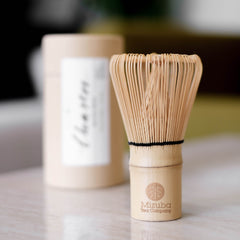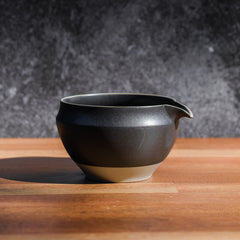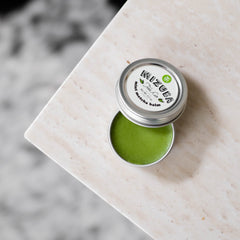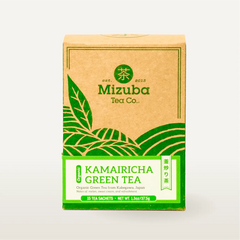Seasonali"tea"
Japanese tea, or any tea for that matter, is closely intertwined with the tides of nature. That shouldn't come as a surprise because tea is a plant, and plants grow according to the seasons. The tea plants hibernate during winter, bloom in spring, thrive in summer and prepare for winter in autumn. This is the natural cycle, and thus our experience of the product also changes with the seasons.
In this article, we will look at the different seasons in the life cycle of a tea bush and also explore how our experience of enjoying tea changes with the seasons.
Tea fields in Uji, Japan (photo by Mizuba Tea Co.)
Whatever comes first
People in Japan absolutely love 'hatsu-mono,' or fresh things. "Of course," you may think! "In Japan, it is popular to eat raw fish, and who doesn't enjoy fresh vegetables?" But the culture of 'hatsu-mono' goes deeper. It has a strong relation to the seasons, and the seasonality of the product. 'hatsu-mono' literally translates as "first things," and in this context it means "the first appearance of a certain food in the term of the current year". This notion is often also referred to as 'shun,' or literally "in-season". But 'hatsu-mono' is initial to shun.
Japanese culture highly esteems enjoying the earliest food before it is in season. This comes from the belief that whatever has been harvested or created first is the purest, most rich, and nutritional product. And this line of thinking is no different for tea.
Spring arrives! "Here's the First Flush; Shincha!"
May 2nd is commonly taken as the first day of harvest. Of course, this date differs for each particular tea-producing region and climate of the year. The Southern region has a warmer climate and therefore producers there may already start harvesting in late April, whereas the colder regions and tea manufacturers located higher up in the mountains may not start until perhaps mid-May. But traditionally May 2nd is termed 'hachiju-hachi ya,' or the 88th evening after the advent of spring, and points to the most ideal timing to harvest tea (especially tea intended for matcha) in the Uji, Kyoto area.
During winter the tea bushes go into hibernation. During hibernation, the bush doesn't seem active on the surface, but it is indeed very active beneath the soil. The tea plant’s roots work hard to gather nourishment to make natural sugars and starch. The plant does this to prevent the roots from freezing during the coldest of winter. Consequently, when the winter is long and especially cold, the bush has to work harder to gather more nutrients in its roots.
For this reason, regions with harsh, cold winters are preferred for tea manufacturing. The reserves of nutrients accumulated over winter imbue the tea with its nourishing and delicious appeal. When the tea bush awakens from its hibernation, the starch, sugars, and nourishment it has gathered in its roots is transferred to the branches to feed the new young buds. It goes without saying that the amount of nourishment the young buds receive is highest in the Spring because the bush has had several months to accumulate beneficial nutrients. It is for this reason that people in Japan look forward to the first harvest each year and is also why many premium quality tea manufacturers decide to only harvest once a year in spring.
Although the tea bush continues to grow for the remainder of the year, spring is the only time the tea plant has had to gather a large amount of nutrition. Consequently, later harvests tend to be less thick in flavor and less dense in nutrients, which is why tea products from later harvests are also lower in quality. You may experience this on an incremental level in that the taste of the tea is not completely gone – perhaps just different, less intense. Note that this is mostly the case for green tea–with black tea it is surprising to see that a strong aromatic tea is often better made with a coarser, bitterer leaf from autumn. (As a general example, CTC, or in tea-lingo, 'cut-tear-curl' Assams that you might find in tea bags).
Fresh tea leaves in Wazuka, Japan (photo by Mizuba Tea Co.)
Should the First Flush be drunk immediately?
The fact that tea leaves that are gathered in spring are categorically the most delicious and nourishing is clear. But does the tea have to be drunk immediately after harvest? 17th Century Japanese herbalist and Confucian scholar Kaibara Ekken emphasizes in his Yōjōkun (Instructions on Nourishing Life) that it is better to let tea age before drinking as this takes the sharpness and edge off. And today, many tencha and gyokuro producers indeed let their teas age before selling them on the market (for example, gyokuro produced in May might not sell until Autumn).
"There are many people now who drink a lot of tea from dawn to dusk…drinking a little tea after a meal helps digestion and quenches thirst. Salt must not be added, as it’s bad for the kidney. One must not drink tea on an empty stomach as it damages the spleen and the stomach. One must not drink too much of koicha, as it damages the qi generation of a person… People with weak constitution must not drink that year’s shincha at all. It will cause eye problems, anemia, and diarrhea. You should only drink shincha after the first month. For people with good constitution, drinking it after the ninth or tenth month should not be harmful."
The timings may sound confusing because the months referred to here are the lunar calendar dates. The shincha harvest happens in the second month of the lunar calendar, which is around April. The suggestion to "only drink shincha after the first month" points to the lunar New Year of the following year, which is a 10 to 11 month wait. The ninth or tenth month translates to November and December.
Kaibara here warns that drinking shincha right after harvest could be harmful because it is too fresh and powerful. If you have had shincha you know that it can be rather vegetal and stingy. Because of its youth it contains a high amount of amino acids, catechin, caffeine, vitamins, etc. And having too much of this could *potentially* put too high a burden on the stomach and make you feel nauseous or cause other unwanted side effects.
The suggestion, therefore, is to enjoy shincha in moderate amounts. Some tea manufacturers suggest that drinking the shincha of the current year is important because each year the tea provides us with the nourishment and vitamins we need to cope with the situations we will face during that year. For example, in 2018 a manufacturer in Nara was struck by the bitterness of that year’s shincha. The firm consequently postponed that year’s shipments. After two weeks the bitterness had settled, and the flavor returned to normal. Afterward, they regretted this decision. Each year the firm ships the first harvest out as soon as it is finished to allow customers to drink the new tea as soon as possible, in order to get through the coming year in good health. In retrospect, they now believe that the extreme bitterness in the fresh tea was a reaction from the plant to provide us with the nutrition to cope with the record-breaking heat during the summer of 2018.
Ageing for green tea
In Kaibara’s opinion, it is better to let the freshly harvested tea rest for at least half a year. During the period he lived, leaf teas as sencha or gyokuro weren’t available yet. It was mostly matcha that was produced and consumed throughout Japan. And it makes sense that Kaibara warns against drinking matcha right after harvest.
During the Edo period, it was customary for tea connoisseurs from the shogunate to descend to Uji, Kyoto to fill an urn with the highest quality first flush tea. At the time, this was tencha, the base material for matcha. Carrying this urn back to Edo (Tokyo) required an entire procession and took about half a year! By the time the urn reached the capital, the tea had matured for half a year. And the urn’s arrival at the capital marked the celebration of the first consumption of that year's fresh tea.
This custom is preserved in the tea ceremony even today. During the summer months, the sunken hearth in the center of the tea chamber is sealed, and the service of tea is conducted using the floor brazier. This change takes place right after the first harvest of tea and it is customary to place a sealed jar with fresh tea leaves (tencha) in the hearth. In November the hearth is opened again to be used during winter and this event is referred to as "a tea person's New Year."
The celebration around the opening of the sunken hearth marks the completion of one whole cycle in the tea ceremony tradition. Simultaneously, it is the first time that that year's tea is ground into fine matcha powder and savored. In analogy with the traditional procession of the tea urn to the capital, tea practitioners store the tea for half a year, and only drink it after it has had sufficient time to mature.
Matcha vs. Sencha
Matcha has been drunk and enjoyed in Japan since the 1200s. On the other hand, sencha was only introduced in the mid 18th Century. While it is clear that matcha is traditionally aged extensively before consumption, sencha is often drunk as soon as the new harvest becomes available. Perhaps it makes more sense because sencha is usually an infusion of the tea leaf, whereas with matcha you consume the leaf in its entirety, and this could have a heavier impact on the stomach.
Fresh sencha is usually sharp and green, often with a faintly stingy attitude, yet this “attitude” reveals the tea’s youth and vigor. After a while sencha’s sharpness will diminish and settle down. The corners become rounded, sharp flavors taste more mellow and a gentler sense of sweetness is revealed in the brew.
The spring season’s renewed energy of life invigorates us. It is believed that shincha tea provides us with the energy and nourishment we need to get through the challenges of the coming year. Enjoying freshly harvested shincha leaf tea gives us a boost and helps to uplift our spirit with its freshness and youth.
But as the year progresses and the tea mellows down, we too wind down again as we approach winter. During this time we look for something more warming and soothing to drink (teas such as houjicha, bancha, and kyo-bancha are particularly cozy – even sencha calms down as it sits through the season, and provides us with a more soothing attitude in winter as opposed to its stingy attitude it has in spring.). And, as if the tea understands our needs, the refreshing capacities of the tea now become more calming and embracing.
'Kuradashi-cha' - Aged green tea
In autumn most tea vendors introduce that year's 'kuradashi-cha', or “stored tea.” The tradition of having stored tea has two major significances. 1. It provides us with the kind of warming, calming tea our bodies desire when reaching winter. 2. It is the leaf tea variant on the tradition of storing matcha for half a year before the celebratory “first-time” consumption of that year's tea. Kuradashi-cha can be any type of tea, such as sencha, gyokuro or kabusecha.
A first flush tea is always a first flush tea regardless of when it is drunk. But its character changes with the amount of time it was aged. Shincha is used only to refer to the newly harvested tea right after the tea has been manufactured. The word kuradashi-cha is used when the tea has matured for approximately half a year.
Interestingly, matcha (and in most cases gyokuro as well) is almost always aged before it is sold. Contemporary tea wholesaler firms store the tencha tea for half a year before they make a new matcha product with it. However, in recent years the tea market in Japan has known the advent of a new product: shincha matcha. This shincha matcha is matcha from the new harvest, sold immediately after manufacturing in spring. While shincha for leaf tea may be a treat, keep Kaibara's warnings in mind when approaching shincha matcha.
Conclusion
Can we perhaps say that tea knows our needs better than we do ourselves? In spring the fesh shincha supplies us with the nutrition we require to get through the year in good health. As the year progresses, fresh tea starts to mature and settle down. By the time winter approaches, that same “jumpy” tea from spring now functions as a soothing blanket on a cold winter night.
Kaibara warns us against the perils of drinking fresh tea too early on. But knowing that it also provides important benefits to our wellbeing, we shouldn’t do away with the whole idea immediately. Balance is important, and in this case, it seems safe to assume that Kaibara discusses the perils in a case of excess. As long as we are mindful of how much shincha we drink and continue to listen to our body, then we should sufficiently be able to enjoy the benefits of this year’s spring tea!











Leave a comment